White bathroom tiles: material features and finishes

When choosing a finishing material for a bathroom, many people prefer white tiles. It would seem a boring color, devoid of emotional coloring. In fact, the popularity of such cladding is due to a number of factors. These are its advantages, shapes, sizes, texture and design subtleties.





Color features
White bathroom tiles are a design classic. Today stylists have learned to change their perception by varying the texture, including contrasting tones, the correct pattern and quantity in the bathroom interior. The compatibility of white with other tones is explained by the fact that it consists of all the colors of the color palette. White itself is neutral. But it takes on any emotional coloring when adding a color tone, whether it be the decor of furniture elements or the tone of the pattern of the dice.



Advantages and disadvantages
It is worth getting to know more about the features of this finishing material for the bathroom through the advantages and disadvantages.
The benefits of white bathroom tiles are obvious.
- It makes the space brighter. This allows you to fill with light even a dark and small room.
- The color is able to visually change the dimensions of the bathroom. Due to such tiles, the bathroom will seem more spacious.
- She is aesthetically pleasing. This design looks fresh, stylish and modern.
- The white color of the material is appropriate in any interior style. It has no design restrictions.
- It is made from quality raw materials using modern technologies. Due to this, it is durable and durable.
- It is fire resistant. You do not have to be afraid of a short circuit, the tile will not light up.

- The cladding does not react to temperature changes. It does not crack or deform during operation.
- The finishing material is suitable for use in the bathroom. It does not react to moisture, splashes, water, steam.
- This tile is easy to clean. Often a clean, damp cloth is sufficient to clean the surface.
- The cladding has a wide assortment. On sale you can find options for any, even the most demanding taste.
- It is abrasion resistant. The protective coating eliminates the loss of attractiveness during operation.
- Manufacturers provide an approach to each customer. This allows you to buy coverage based on your budget.
Using white tiles, you can zone the space. It can be an accent of decoration or a background of bathroom decoration. On such a wall, furniture, plumbing, and accessories stand out. White tiles can become the basis for contrasting panels, colored mosaics. Mirrors in any frames look beautiful against its background.

It can be combined with plastic panels and slats. Color allows you to hide imperfections in styling (especially when using white grout). It visually erases the boundaries of the bathroom floors, which is especially good for small rooms and combined bathrooms of old layouts.
White tiles also have several disadvantages.
- She is easily soiled. Even the slightest contamination is noticeable on such a surface.
- Such tiles should not be the only shade of bathroom decoration. Otherwise, the interior becomes boring.
- She is demanding on the whiteness of the shade, which is especially important when buying companion tiles.
- Wall tiles are fragile. It may break during transport and before stacking.
- We need a stock for marriage and pruning.We'll have to take care of additional tiles, the lack of choosing the desired whiteness and pattern is not always possible.
- For the floor, such a finish is impractical. We have to combine it with other finishing materials.

Varieties
Today, all types of facing materials can be divided into 2 types: wall and floor tiles. Each species has its own characteristics. For example, ceramic wall tiles are thinner, so their weight is less than flooring counterparts. Often such dies are small. This also affects the thickness: the larger the fragment, the thicker.
One of the categories is white mosaic type tiles. In fact, this is the same ceramics, only of a reduced size: mainly small squares, which are glued in the traditional way, observing an identical distance between the elements. A variation of such a tile is the modification on the grid. These are squares or rectangles already glued to the grid, laid out in a certain pattern. This version of the material saves time for laying out the pattern, allows you to maintain the identity of the seams between the dies.






Wall and floor varieties can have a different type of texture. Depending on the manufacturing technology, it can be matte or glossy. The presence of reflectivity allows you to visually expand the space. The textures look good together, the abundance of gloss is today considered an unsuccessful approach to decorating a bathroom.
On a white surface, traces of lime from hard water are less visible. However, the glossy texture will demonstrate them. It is chosen to highlight the walls and in cases where you need to make the dominant white color. The matte variety softens other tones. It is chosen with a contrasting companion with a similar texture. In addition, white tiles can be smooth, embossed and rough. The pattern on its surface can be three-dimensional, three-dimensional or traditionally contrasting. Sometimes it is an imitation of a mosaic, often brickwork (a kind of siding for interior decoration). In other cases, it is a panel image consisting of a number of fragments.




The combination of smooth and textured varieties allows you to achieve an unusual effect when drawing up the interior background of the bathroom. Manufacturers produce a wide range of similar products for bathroom decoration. Collections are constantly updated, to make the background complete, you can choose a border, a mosaic panel to the white tile, create a different-sized version of the wall decoration. An interesting variety "hog" with a chamfer, which can have straight ends.
Some varieties can be used as support for wall slabs. For example, you can tile the walls of the bathroom box, decorate it with mosaics, and partially decorate the cabinet under the sink. Others are suitable for laying out the floor pattern together with artificial stone flooring. Depending on the shape and design approach to decoration, tiles are glued in the traditional, diagonal, modular way, with offset techniques, herringbone laying, with a shift.


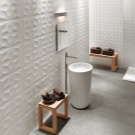



Forms
Today, white tiles have mainly two basic shapes: rectangular and square. At the same time, it is not difficult to visually make a rhombus out of a square. To do this, it is glued diagonally. Less often, for wall decoration, options in the form of hexagons, diamond-shaped, wedge-shaped, triangular fragments are used. The most popular type of material is a brick shape.
Laying tiles with bricks looks beautiful and modern against the general background. It is suitable for the design of different stylistic directions of design. For the floor, square options are used. Sometimes (for example, if you need to create the illusion of carpet), it is diluted with dies of the same size with the pattern and supplemented with borders.


Dimensions (edit)
The dimensions of white tiles depend on their type, although recently trademarks have begun to set standards on their own, releasing products for cladding.Previously, wall tiles were smaller in length and width compared to floor tiles (15 x 15, 20 x 20 cm). Today, you can find products of different sizes on sale. The most popular sizes for wall decoration are 10 x 10, 20 x 20, 20 x 25, 20 x 30, 25 x 25 cm.
It is more difficult to find companions for sizes 25 x 33, 25 x 36 cm. Therefore, you have to choose from collections with more common dimensions. Some dimensions for walls and floors are the same (30 x 60, 40 x 60 cm). However, experts do not recommend finishing the walls and floors with fragments of the same size and shape. This simplifies the bathroom interior.

Combination with other colors
White tiles on walls or floors can be combined with different tones of the color palette. If for the walls it is meant to use the cladding of one wall, experts advise to separate them by means of a relief or pattern. For example, it can be a bath screen trim with support for one of the walls, a niche trim, a wall behind the toilet, if the bathroom is combined. Embossed matte tiles in white look better than smooth glossy ones.
Delicate combinations are combinations of white with pearl, silver, light gray. With the support of metal chrome surfaces, white tiles will look beautiful. However, in order for a neutral bathroom interior to acquire an emotional color, it is better to choose matte tiles with a texture and a shade of wood for the floor. Beige-silver marbled stains on the floor will be appropriate here.

Tiled classics with gold and bronze tones look beautiful. Such an interior acquires elegance, even if there is little decoration. A harmonious combination of white with beige, milk, cream, olive, blue tones. Green, peach, and yellow make the atmosphere special. Coral, turquoise, mint are also relevant.



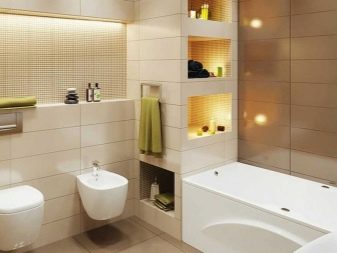
Combinations with bright and strong colors must be thoughtful. Black and white, red and white, white and blue bathroom - complex solutions. Energetic red will not allow you to relax, black in large quantities creates an oppressive atmosphere. Blue blows cold. Warm tones set up the atmosphere of home comfort. It is better to replace red with wine or orange. The orange and white bathroom is more comfortable.
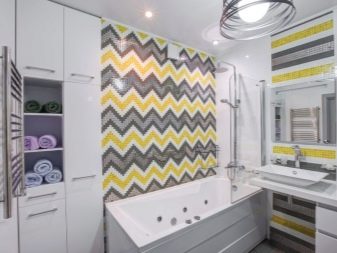




Design Tips
Not everyone can harmoniously create a bathroom interior with white tiles. Sometimes the space ends up being overloaded with an abundance of carved elements or patterns. In this case, even colored plumbing and furniture do not save the day.
To help in this situation, it is worth understanding the essence of the mistakes and focusing on the intricacies of the design.
- When choosing a material, it is worth considering the type of lighting devices, their decor, the design of the shades and the shape. This is especially important if there is a pattern on the tile.
- You can pay attention to the accessories. Sometimes it is they who change the perception of the interior.
- Do not overload the surface decoration with flowers on a white background of all coating surfaces. One accent is enough in the bathroom.
- Combining tiles with mosaics, the purity of the shade must be selected as accurately as possible. Otherwise, the integrity of the cladding will not work.

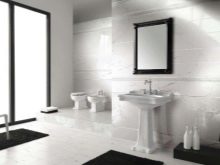

- It is undesirable to use black, gray or other colored grout to decorate white tiles. However, if the coating is colored, this is possible.
- Small amounts of dark tones make white tiles expressive. It is better to use them in the form of a picture. Filling large areas distracts attention from the white.
- The size of the dies is selected in accordance with the footage of a particular bathroom. The smaller it is, the simpler and smaller the decor. Large fragments will visually hide valuable centimeters of usable area.
- The use of tiles on the wall and the bathroom screen looks beautiful. Walls from one variety lose their expressiveness. It is allowed to use two different versions of the material in shape and pattern.
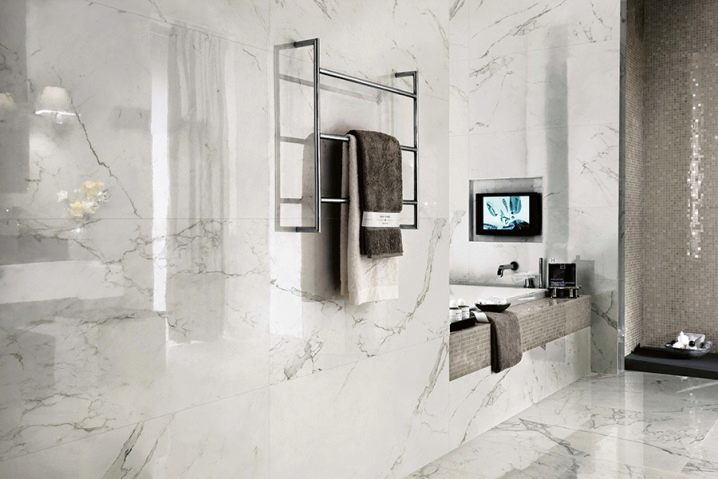
With regards to lighting devices, you need to choose a tile so that it is combined with them. These can be built-in spotlights or wall sconces, options with reflectors, and even a tape that is hidden behind a mirror. To achieve harmony when choosing a certain style, you can pay attention to the drawing. For example, a tile decor can be supported by an unusual vase with a similar print, a soap dish, or a plafond finish.



Interesting examples
You can get inspiration from the examples in the photo gallery. They will show you the possibilities of using white tiles.
- Mosaic-effect tiles in neutral tones bring boredom to the bathroom surface.

- The use of white and black tiles, a combination of monochrome fragments and dies with a lace pattern.

- Stylish solution for a narrow bathroom. A gray-beige apron under the mirror and a light floor are combined with brick-like tiles.

- The combination of a white bar with a chocolate bar. Created a panel effect. The floor covering draws out the laconic design.

- White tiles with beige streaks and marble imitation are combined with lace trim. Supported by the dark touches of the interior, the interior looks expressive.

- The combination of marbled white with green and woody contrasts looks beautiful and fresh.

- Harmonious use of muted blue. Due to the 3D drawing, the effect of niches is conveyed. A practical solution for floor cladding.

Reviews
White tiles are really popular and can make your bathroom look special. This is evidenced by customer reviews. Comments left on the forums speak of its excellent decorative capabilities, the ability to make the bathroom interior lighter, fresher and more luxurious. White tile is unique - it is noted in the reviews - it fits into any direction of stylistics. It doesn't matter if you choose classic, modern, vintage or ethnic style. She is able to show different textures, including painted wood with an aged effect, marble and brick.





You will learn how to lay tiles in the bathroom in the next video.













The comment was sent successfully.